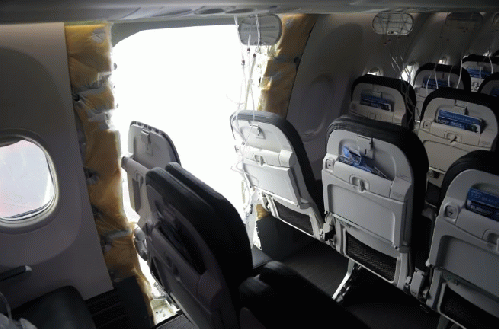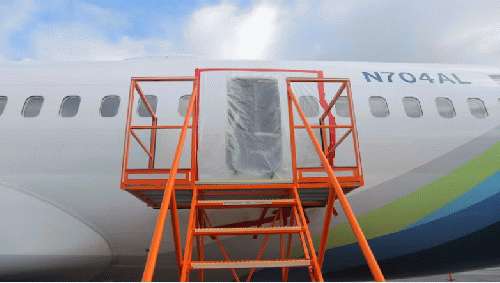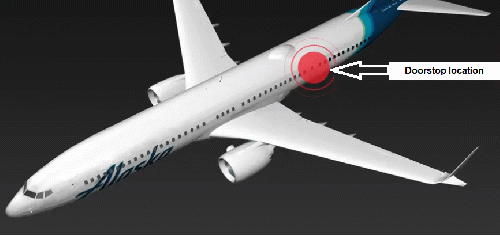| Back OpEd News | |||||||
|
Original Content at https://www.opednews.com/articles/Are-the-737-Jets-Safe-for-Aircraft_Jets-Crash-240128-625.html (Note: You can view every article as one long page if you sign up as an Advocate Member, or higher). |
|||||||
January 28, 2024
Are the 737 Jets Safe for Return to Our Skies?
By Robert A. Leishear, PhD, PE, ASME Fellow
'FAA approves a path for Boeing 737 Max 9s to return to operations', and yet the evidence for the cause of the failure is questionable. Bolts were gone from the doorstop that flew off the jet aircraft, and multiple doorstops had loose bolts. Bolts do not come loose on their own. We are being asked to believe that trained technicians are too stupid to tighten bolts when they build jet aircraft. Make sense to you?
::::::::
'FAA approves a path for Boeing 737 Max 9s to return to operations', starting January 26th, 2024 (click here), and yet the evidence for cause of the failure is certainly questionable. Even though information is being withheld from the public, the scant information that is released to us implies that fatigue cracking may not, or may, have been a principal failure cause ("Was the Boeing 737 Door Blow-out the Starting Line For a Race to Destruction?"). However, the bolts were gone from the doorstop that flew off the jet aircraft while the jet was in flight, and multiple doorstops had loose bolts. Bolts do not come loose on their own.
Repetitive vibration cycles can loosen bolts. In my decades of engineering troubleshooting of broken machinery and equipment, the loosening of bolts and fatigue cracks are both caused by cyclic loads as vibrations flex structures back and forth. Inspections can determine if bolts are loose, but inspections alone will not, and cannot, determine the root cause of this type of failure.
We are being asked to believe that trained technicians are too stupid to finish tightening bolts when they are building aircraft. We are being asked to accept that these aircraft are being returned to service with a questionable failure cause, i.e., a supply chain problem, or quality problem, is touted as the sole cause for aircraft failures. Are the technicians being scapegoated for a jet aircraft design flaw?

Figure 1. A 737 doorstop blew off at 16,300 feet in the air (more than 3 miles up).
(Image by NTSB, US government) Details DMCA

Figure 2. Can another doorstop of a 737 jet aircraft fly off of the jet during flight?
(Image by NTSB, US government) Details DMCA
'The first of our 737-9 MAX will resume flying on Friday, Jan. 26, with more planes added every day as inspections are completed and each aircraft is deemed airworthy.' Is there a quality control problem or a design flaw ('Alaska Airlines says expects $150 mn hit from 737 MAX grounding', click here). Aircraft vibrations and forces on bolts can result from turbulence, engine vibrations, and the expansion of the aircraft fuselage, or skin, as the jet rises in the air to low pressures at high altitudes. Are these jets safe to return to service?
If the current investigation is inadequate, are jets safe? If not, can a stewardess or passenger be sucked out of a jet - several miles in the air - if another door stop explodes from a jet? ('How can a person be physically sucked from an airplane? A former pilot explains', click here).
Two Max8s crashed and killed everyone on board (Flying on a Boeing 737 Max 9? Here's what to know", click here). Can a door stop blowout on a 737 Max9 to strike the tail of that jet to send the jet into a sudden fatal tail spin?
I am not making specific accusations, but I am asking that we be provided answers to important safety questions that affect our lives. That is, a report of a completed failure investigation should be available to the public. Our lives may be endangered.
Addendum
The FAA was forwarded the following message. Boeing and the NTSB have no available email addresses for safety concerns.
Are the 737 Jets Safe for Return to Our Skies?
Based on presently available FAA communications to the public, I question FAA safety decisions concerning return to service of the 737 Max9 jet aircraft. An OpEd News article summarizes these safety concerns (link provided).
(Article changed on Jan 30, 2024 at 9:34 AM EST)
Authors Website: http://www.leishearengineeringllc.com
Authors Bio:
Robert A. Leishear, PhD, P.E., PMP, ASME Fellow, Who's Who in America Top Engineer, Who's Who Millennium Magazine cover story, NACE Senior Corrosion Technologist, NACE Senior Internal Piping Corrosion Technologist, ANSYS Expert, AMPP Certified Protective Coatings Inspector, NACE Cathodic Protection Tester, Structural Steel Worker, Welder, Carpenter, and Journeyman Sheet Metal Mechanic, is a Consulting Engineer for Leishear Engineering, LLC, and worked as a Lead Research Engineer (Principal Researcher) for the U.S. Department of Energy's (DOE) Savannah River National Laboratory (IQ = 161). He has also worked as a design engineer, test engineer, and plant engineer in nuclear waste facilities and nuclear fuel reprocessing facilities.
Additionally, Dr. Leishear worked as a lead electronic packaging design engineer for military aircraft and missile systems. In this position, he designed the first wireless aircraft radar system, and he patented an electromagnetic interference mechanism to ensure that aircraft radar computer systems remained operational for second strike capabilities in the event of nuclear war, where this mechanism was installed on all personal computers and printers for decades.
Dr. Leishear has written more than 190 technical publications on water hammer, nuclear plant explosions, and other research. Publications by the American Society of Mechanical Engineers include two water hammer and piping design books and Honors Journal publications.
Dr. Leishear received the Mensa, Copper Black Award for Creative Intelligence for his research on nuclear power plant explosions and petroleum industry explosions. He was appointed as an ASME Fellow for his research on water hammers, which are directly applicable to industrial explosions.
Dr. Leishear earned a B.S. in Mechanical Engineering from Johns Hopkins University, and at the University of South Carolina, he earned M.S. and PhD degrees in Mechanical Engineering, and also earned a Master of Engineering degree in Nuclear Engineering. For these degrees he studied, fracture mechanics, water hammer, fluid mechanics, mass transfer, gas dynamics, materials science, fatigue cracking, advanced thermodynamics, reactor thermal hydraulics, risk analysis, engineering law, reactor design, reactor physics, radiation shielding, reactor materials science, nuclear fuel cycles, reactor water chemistry, nuclear material safeguards, finite element analysis, structural vibrations, machinery vibrations, HVAC design, combustion, explosions, and structural analysis.
He has also extensively studied nuclear reactor physics, nuclear reactor thermal/fluid modeling, and nuclear reactor fuel design through Oak Ridge National Laboratories, the University of Illinois, the University of Barcelona, and the U.S. NRC; 12 corrosion courses through the Association for Materials Protection and Performance (AMPP/NACE); water treatment classes through the American Water Works Association; 7 combustion courses through the Combustion Institute at Princeton University and CERFACS; 20 Fluent and Ansys computer modeling courses; plus International Nuclear Law at the University of Singapore and International Radiological Protection at Stockholm University in Sweden through the OECD, Nuclear Energy Agency.
He also completed two years of full-time training at the DOE, Savannah River Site to understand infrastructure, diesel engines, pumps, compressors, fans, heat exchangers, evaporators, steam systems, air and nitrogen systems, mixing, instrumentation, calibrations, machinery design, fire protection systems, safety analysis, emergency response, radiation worker, electrical worker, first aid, explosion risks, plus 17 ASME courses on pressure vessel design, inspection, and piping design. At SRS, he also studied nuclear industry processes, which included chemistry, radiochemistry, and physics for nuclear waste disposal and nuclear fuel reprocessing. He was also trained for 6 weeks at SRS as an HVAC, electrical, and electronics systems mechanic.
Prior to his academic education, Bob Leishear earned his indenture papers through a four-year sheet metal apprenticeship, and he attended six months of training to learn to weld, build steel plate construction, and cut steel with an acetylene torch.
